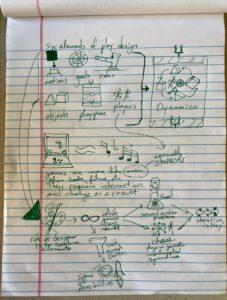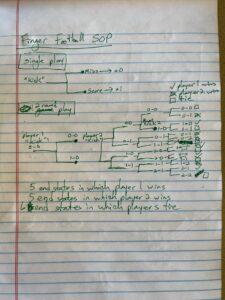Sketchnotes

Exercises
1. Identify the basic elements in a game of your choice (actions, goals, rules, objects, playspace, players).
My game of choice is Wordle, which I play everyday and compete with my dad.
Actions:
- Enter five of 26 English letters to form a word
- submit (guess) word
Goals:
- guess the secret word in less than six tries.
- (optional) minimize number of guesses to beat other players
Rules:
- A guess must consist of five letters
- If a letter in a guess is in the same location in the answer, that letter square turns green
- If a letter in a guess is part of the answer, but is in the wrong location, the letter turns yellow
- If a letter in a guess is not part of the answer, the letter turns grey
- If all five letters in a submitted word turn green, the player wins
- If a player does not win in six submissions, the player loses
Objects:
- The 26 letters of the English language
- A keyboard to enter letters and submit guesses
Playspace:
- A 5 by 6 grid
Players:
- Single user who guesses according to the rules
- (optional) Multiple users who share/compare results on the same puzzle and their stats over time
2. As a thought experiment, swap one element between two games: a single rule, one action, the goal, or the playspace. For example, what if you applied the playspace of chess to basketball? Imagine how the play experience would change based on this swap.
What if Wordle used the play space of tic-tac-toe? The guesses would now be limited to three, and each word would only be three letters long. While there are less guesses, there should also be less words to guess (there are significantly more ways to combine 26 letters in five-letter sequences than three-letter sequences. I don’t expect removing combinations of letters that don’t have existing definitions would change the ratio of five-letter words to three-letter words too much). So, each guess is now more likely to be right, but you are allowed fewer guesses.
I think the game would be less fun overall. Most likely, the game designers tested different grid dimensions and settled on 5×6 as the most engaging. For example, it’s not hard to imagine how it would be less fun to win by guessing “and” or “now” instead of words like “smile” or “great”.
3. Pick a simple game you played as a child. Try to map out its space of possibility, taking into account the goals, actions, objects, rules, and playspace as the parameters inside of which you played the game. The map might be a visual flowchart or a drawing trying to show the space of possibility on a single screen or a moment in the game.

4. Pick a real-time game and a turn-based game. Observe people playing each. Make a log of all the game states for each game. After you have created the game state logs, review them to see how they show the game’s space of possibility and how the basic elements interact.
Real-time game: Age of Empires IV (1 human player v 3 computer opponents)
| State | Description |
| Setup | The player decides the specific rules for the instance of the game, including the number of other players, difficulty level, map size (playspace), starting age, resource prevalence, and victory conditions (goals). The player I observed chose a standard game with three other players and the “conquest” victory condition. |
| Start | The player begins with limited resources and a few “settlers” they can use to gather more resources. The primary objectives in this phase are to establish a basic economy and explore to identify resources. The player avoided opponents in this phase. |
| Early “Age” States | The players collected resources and spent those on several simultaneous objectives: constructing landmarks needed to advance to subsequent ages and training military units, primarily to defend. However, the player I observed did attack a nearby rival in the Feudal Age, a fairly early age for attacks. The attack, a “rush”, . |
| Mid “Age” States | As the player and rivals expanded their civilizations, they began to encounter one another more. Because they also have stronger economies in these phases, the confrontations more easily developed into conflict, especially over resources. |
| End “Age” States | In this later stage, equipped with advanced weapons, large armies, and a strong economy, the player began launching full-scale campaigns against their opponents. |
| Victory State | The human player I observed did not achieve the victory state, but an opponent did when that opponent conquered the human player. |
Turn-based: Chess (1 human v 1 computer)
| State | Description |
| Setup | Standardized and follows specific rules. Same for every game. |
| Opening | Characters make their first moves, normally trying to control the four central squares of the board. Because previous players have analyzed games for so long, the strategy and “best moves” during an opening are fairly well-defined and tend to evolve pretty predictably from turn to turn. |
| Middlegame | By this point, small variations in strategy during the opening have created a complex, potentially unique game in which the “best move” is less well-defined and is determined more by intuition and in relationship to the other player’s strategy. Good play combines eliminating the other player’s pieces and positioning one’s own pieces with lots of leverage for the endgame. |
| Endgame | This occurred early because the computer was much better than the human player and was able to position their pieces in strong positions for attack on the king. There were, overall, quite a few pieces left on the board for both players. |
| Victory | The computer was able to use its queen and a knight to trap the human player’s king behind the human player’s own pawns, ending the game with a checkmate. |
The difference between real-time and turn-based states that jumped out most to me is that states in a real-time game are less discrete. Most states, other than the start and end states, are not easily described. I chose to define states using the “age” structure provided by the games, but you could also seemingly define a state as any momentaneous snap-shot of the game, which would result in an overwhelming number of states. Additionally, at least in the real-time game I observed, each player need not even progress through states at the same rate as their opponents in that same game. There is an overall, macro state of the game, but because the game I chose includes smaller sub-games like resrouce acquisition and unit training, states for individual players can be unrelated to those of other players. This blurriness of states and asynchronous progression through the game creates a huge space of possibilities. Players can use strategies that take advantage of asynchronous progression, spending resources on immediate power or investing in more advanced abilities in the future. The huge space of possibilities also means there is much less structure at any given moment in the game and a greater potential for the game to become chaotic. The designers seemed to impose structure through other elements, especially the “age” system, rules about how to proceed through stages, and associated rewards for doing so.
By contrast, the turn-based game Chess had much more structure from instant to instant and much more clearly defined states. I defined these states at a game “stage” level, which allows for an easier analysis of general dynamics at work and how they change throughout the game. But, I could have also defined states at the “turn” level by identifying the exact position of each piece on the board after every turn.
While the space of possibilities of a game of chess is still huge, it’s significantly smaller than that of Age of Empires because the designers of the game chose to restrict the playspace, number of players, and win conditions, as well as standardize the setup. Additionally, complexity is reduced by only allowing one player to move at a time. As a result of these restrictions, the chess game evolved in a way that made it easier to understand who had the advantage at any moment in time. Because of the chaos of Age of Empires real-time evolution and simultaneous move-making, it was really hard to understand which player had the advantage during most moments of the Age of Empires game, unless a player’s advantage was overwhelming.
That said, there were still some notable similarities between the two kinds of games and how the space of possibilities evolved. Both began with “simple” initial states, in which the space of immediate possibilities was relatively small and the consequences of any action were easier to understand. This comprehensibility fell over time as the elements interacted to generate more complexity. Both became less complex as the chaos of the midgame generated a clear advantage for one player that allowed them to eventually win.



